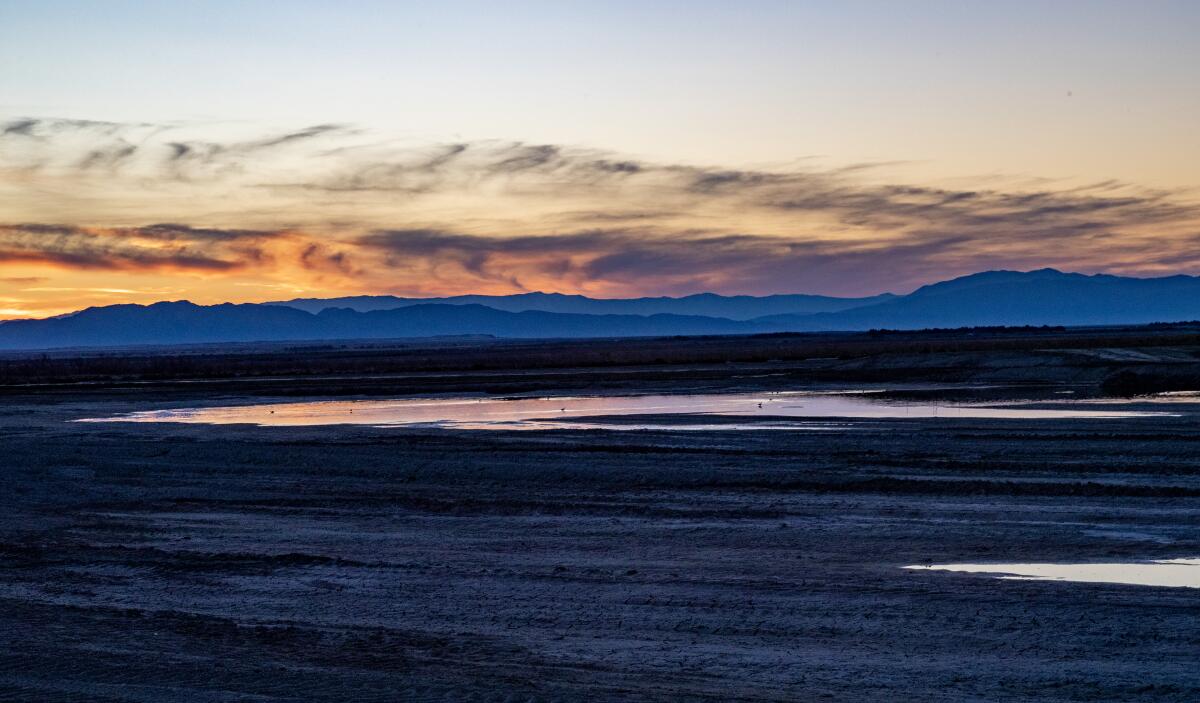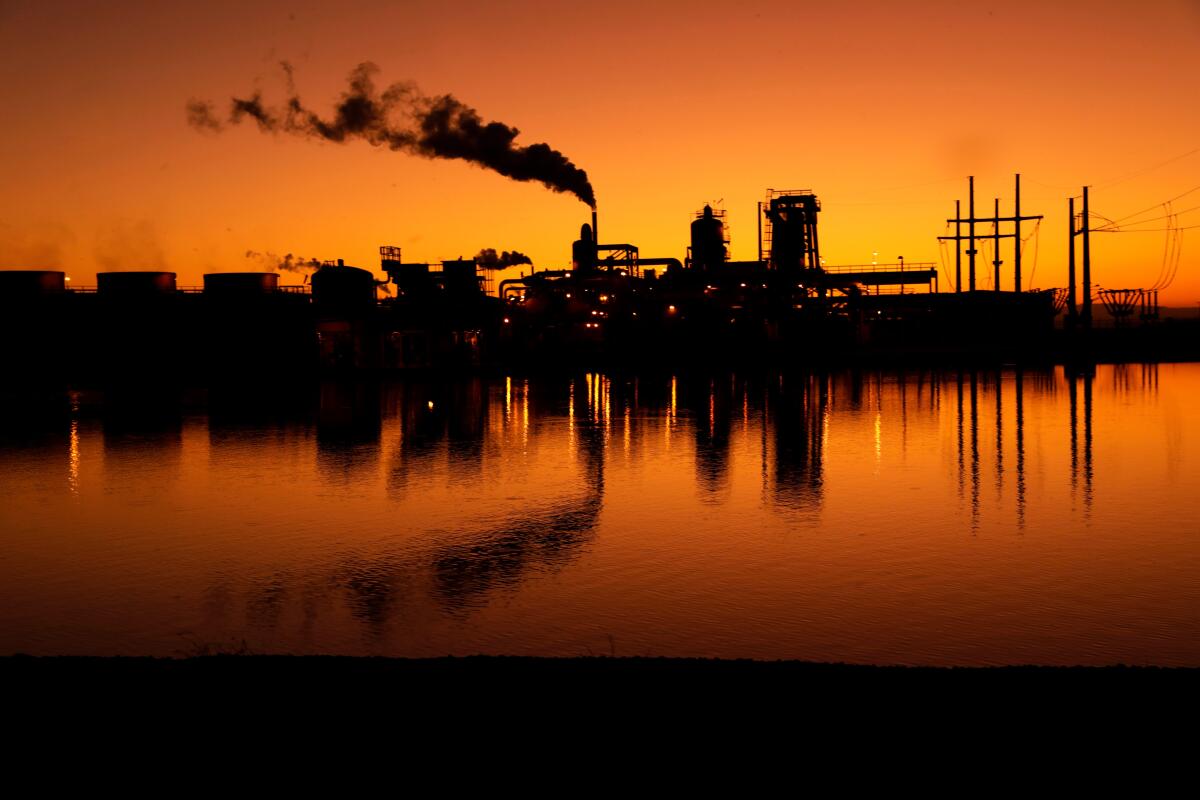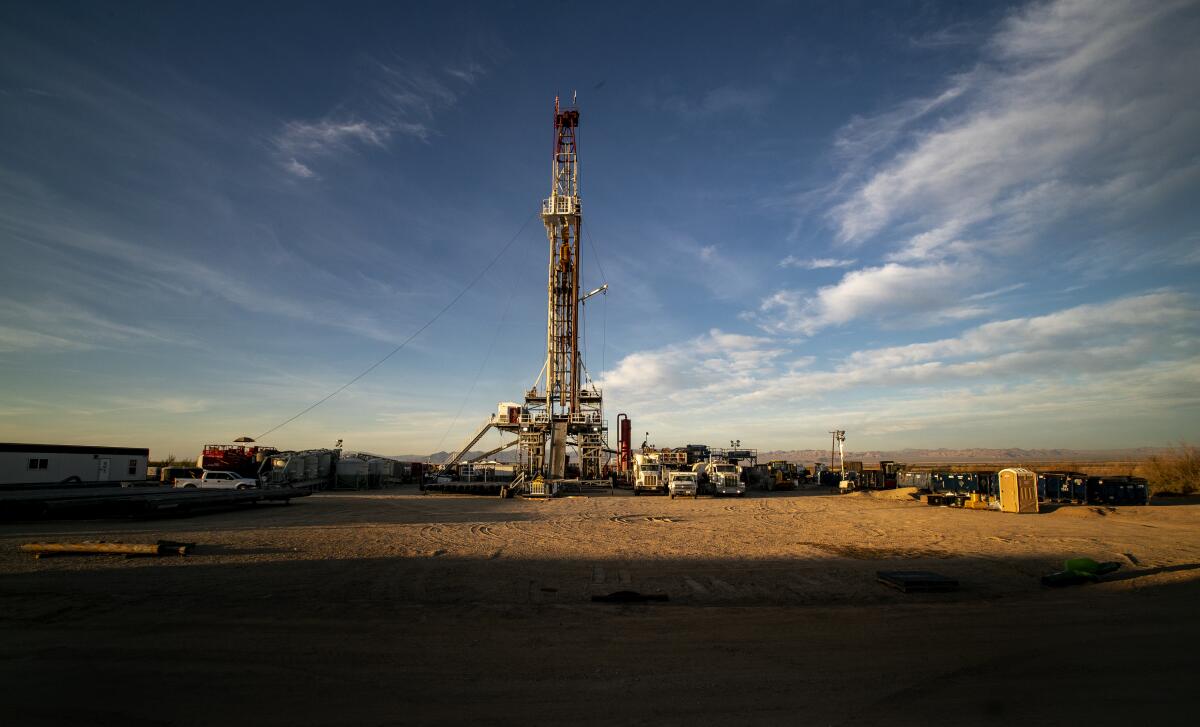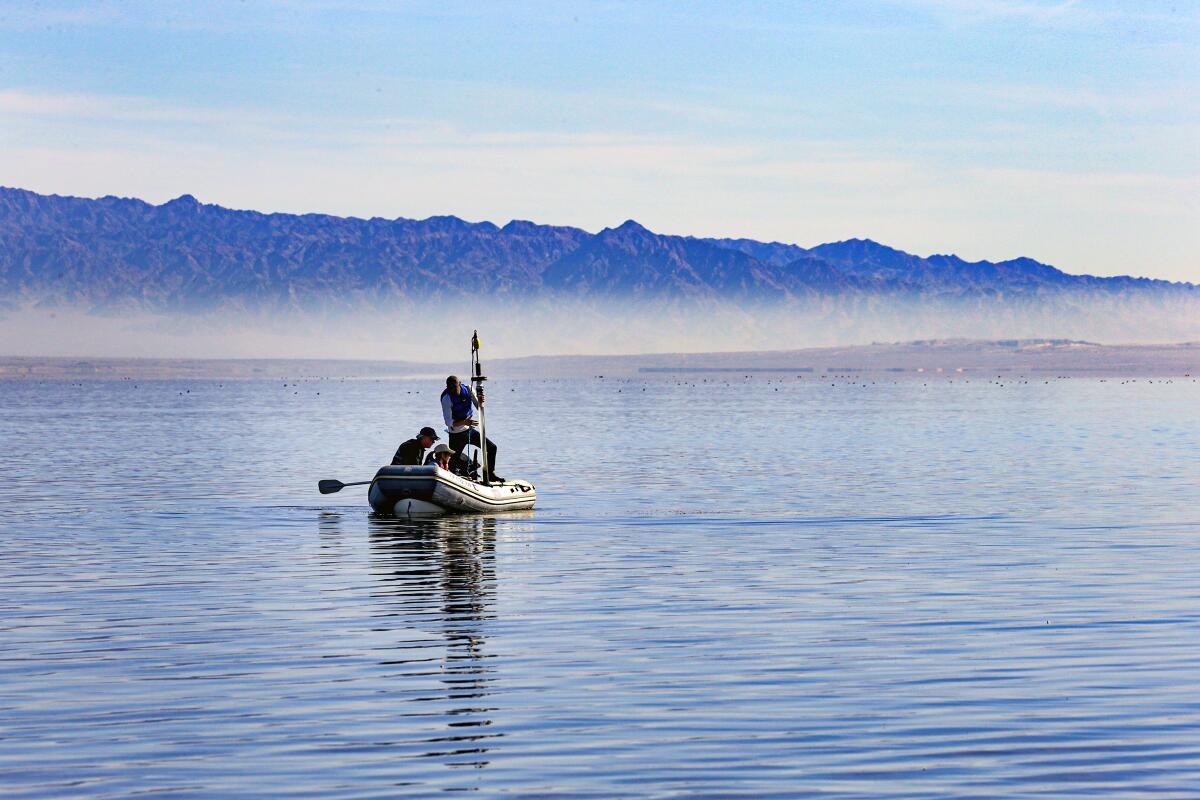The Salton Sea has even more lithium than previously thought, new report finds

- Share via
Want to produce a huge amount of lithium for electric vehicle batteries — and also batteries that keep our homes powered after sundown — without causing the environmental destruction that lithium extraction often entails?
Then the Salton Sea may be your jam.
Companies big and small have been swarming California’s largest lake for years, trying to find a cost-effective way to pull out the lithium dissolved in scorching hot fluid deep beneath the lake’s southern end. Now a new federal analysis suggests even more of the valuable metal is buried down there than we previously understood.
You're reading Boiling Point
Sammy Roth gets you up to speed on climate change, energy and the environment. Sign up to get it in your inbox twice a week.
You may occasionally receive promotional content from the Los Angeles Times.
The new analysis — led by researchers at Lawrence Berkeley National Laboratory and reported here for the first time — finds we may be able to extract 18 million metric tons of “white gold” from the heated underground pool, which is not connected to the surface lake. That’s the first thoroughly documented public estimate of how much lithium is available at the Salton Sea, said Alex Prisjatschew, an engineer with the U.S. Department of Energy, which funded the analysis — and it’s higher than past guesses.
“It’s going to be roughly the equivalent of 382 million electric vehicle batteries,” Prisjatschew told me.
There are fewer than 300 million cars and trucks registered in the United States today. So yeah, that’s a big deal.
Right now, the Salton Sea is best known as an environmental disaster in the making. As fossil fuels heat the planet, water levels have fallen at Lake Mead, forcing farmers in California’s Imperial Valley to limit their use of Colorado River water. The result has been less irrigation runoff flowing into the Salton Sea, causing the desert lake to shrink. Fierce winds are increasingly picking up toxic dust from the drying lakebed and blowing it into the air breathed by Imperial Valley residents.
But for all the lake’s problems, it’s a clean energy mecca. For decades, companies have tapped into the hot water deep beneath the Salton Sea’s southern end to generate geothermal electricity, a climate-friendly power source available 24 hours a day.
With lithium, the Salton Sea area could become an even more central player in efforts to stem the climate crisis.

The Imperial Valley is far from the only place where the silvery white metal can be found. But extraction efforts in other parts of the country — such as Nevada’s Thacker Pass and Utah’s Great Salt Lake — have faced pushback from conservation activists and Native American tribes over their potential to destroy wildlife habitat, gobble up scarce water and desecrate sacred sites.
At the Salton Sea, environmental experts have found relatively little to worry about.
“Across the board, it’s a much more environmentally friendly way to extract lithium,” Prisjatschew said.
Several companies are racing to profit off that resource, aided by state and federal funds. San Diego-based EnergySource, which runs a geothermal plant at the Salton Sea, signed a contract earlier this year to sell lithium to Ford Motor Co. A few months later, Australian startup Controlled Thermal Resources won an investment of more than $100 million from Stellantis — the automaker behind Chrysler, Dodge, Jeep and Ram vehicles — to fund its efforts to generate geothermal electricity and produce lithium.
Meanwhile, billionaire investor Warren Buffett’s Berkshire Hathaway Energy — which owns 10 of the 11 existing geothermal power plants at the Salton Sea — has been trying for years to develop a profitable technique for lithium extraction.
The new analysis adds to the case for continued state and federal investment in the region.
It does not, however, mean we should count on the Salton Sea as a panacea that will solve all our climate problems.
Even after a decade writing about the lake, it’s hard for me to predict whether all the lithium and clean power envisioned by the federal report will materialize. Geothermal energy is expensive, and no new plants have opened in a decade. No lithium is being produced from the underground brine yet either, with a much-hyped lithium startup going bust even after Tesla offered to buy it for $325 million. The highly salty underground brine corrodes equipment, an expensive challenge to resolve.
And even if some lithium companies start succeeding, the 18 million metric ton estimate is a best-case scenario. Without new technologies and a lot more geothermal energy, 4 million metric tons is more feasible, federal researchers found.

There are also a bunch of questions federal researchers are still working to answer, such as how quickly the underground lithium resource replenishes itself — a key piece of information for ensuring sustainable production levels.
“There will be a phase two,” Prisjatschew said.
So putting all our eggs in the Salton Sea basket seems like a poor bet — especially given the urgency of the climate crisis.
The United Nations estimated last week that humanity must reduce emissions of heat-trapping carbon pollution 43% by 2030, just seven years from now, to limit global warming to 1.5 degrees Celsius — beyond which the deadly and devastating wildfires, storms and heat waves of the last few years are expected to get far worse. If that’s not reason enough to accelerate the end of fossil fuels, a new study this month found that air pollution from coal plants is even deadlier than previously thought.
The best way to ensure a safe, healthy future for as many people and animals as possible is to keep investing in as many opportunities for lithium development, renewable energy production and other alternatives to fossil fuels as possible — even in places where those investments may result in local environmental damage.
I’m not saying we should ignore the razing of wildlife habitat by solar farms, the killing of golden eagles by wind turbines or the destruction of places sacred to Native American tribes by lithium mines. As I’ve written previously, we can and must do our best to limit the damage by selecting the least harmful places to build — even if that means slowing down in the short term to try to build consensus, in hopes of speeding up the process in the long term.
We should also be doing everything we can to promote rooftop solar, energy efficiency, public transit and other means of limiting the need for industrial energy projects — even though those solutions won’t be enough to end the reign of fossil fuels.
But as I argued in a column last week, we need to start accepting that staving off the worst consequences of climate change will have side effects. We need to champion solutions such as Salton Sea lithium and geothermal while accepting that not every solution will be quite so harm-free. We need to be willing to put the big picture above our narrow local interests.
That won’t be fun. But neither will 2 or 3 or 4 degrees Celsius of global warming.
On that note, here’s what’s happening around the West:
WATER IN THE WEST

Speaking of the Salton Sea: Small wetlands are forming as the shoreline recedes, created by irrigation water runoff from farms and other businesses that can no longer reach the lake’s edge. Here’s the hopeful story by the Desert Sun’s Erin Rode. In other Colorado River news, a $1.2-billion deal to protect the river’s biggest reservoirs may simply increase the price of existing programs that pay farmers to use less water, while doing little to create new savings. That’s according to this investigation from Politico’s Annie Snider, which explores a deal being finalized between irrigation districts and the federal government.
“The smart, 21st century approach would be to leave Sites on the drawing board.” L.A. Times columnist Michael Hiltzik is not a fan of Northern California’s proposed Sites reservoir, writing that the project — backed by Gov. Gavin Newsom — is undermined by “its immense cost and its uncertain ability to contribute to the state’s water supplies.” Sites is far from the only Western water project designed to help deal with the climate crisis but facing pushback from environmentalists. Wyatt Myskow wrote for Inside Climate News about a proposed pumped hydropower project in Nevada that could interfere with operations of a scenic railroad, and which is seen by many locals as “yet another water grab by big cities, this time to provide them with green electricity.”
More salmon are spawning on Northern California’s Mokelumne River this year than in eight decades of record keeping. That doesn’t mean all West Coast salmon are in great shape — far from it — but the numbers offer a rare success story, as the Mercury News’ Will McCarthy writes. In other river news, Circle of Blue’s Brett Walton has a thoughtful look at a gap in America’s fire recovery regime: a dearth of money to fix up streams, which is important for habitat restoration and flood prevention. Along the U.S.-Canada border, meanwhile, researchers say the amounts of selenium and nitrate pollution entering Montana rivers from Canadian coal mines “are likely without measured precedent,” as Amanda Eggert writes for Montana Free Press.
THE POWER GRID
The federal government is offering new rebates for new and used electric vehicles — and California has a new program too. My L.A. Times colleague Russ Mitchell explains how it all works, including who qualifies for the incentives and what you can do to take advantage of them. The gospel of clean cars is spreading, with New Mexico officials voting this month to require that 43% of new cars and light-duty trucks delivered to the state be electric by 2026, and 82% by 2032, per the Santa Fe New Mexican’s Scott Wyland. New Jersey, meanwhile, followed California’s lead on electric cars last week with a regulation that will ban the sale of new gasoline-fueled vehicles starting in 2035, as Wayne Parry reports for the Associated Press.
Why are California’s monopoly utility companies making bigger profits than ever? The answers include heavy investments in the electric grid meant to prevent wildfire ignitions, keep the lights on after dark and meet state climate goals — investments that are broadly necessary but which critics say the utilities are overdoing to make more money, as the San Diego Union-Tribune’s Rob Nikolewski reports in a great deep dive focused on Sempra Energy subsidiary San Diego Gas & Electric. In related news, California regulators are planning to raise electric bills for higher-income people, to help pay for climate and clean energy programs without putting as much pressure on low-income families. But some politicians say they’re going about it all wrong, Politico reports.
Utilities want to spend more money replacing aging, leak-prone gas pipelines — a valuable safety move. But regulators in California and other states are pushing back, questioning whether it makes sense to stick utility customers with the high costs of replacing pipelines when limiting climate change will require using a lot less gas in the long term, as the Wall Street Journal’s Katherine Blunt reports. For an example of the kind of investment we definitely need more of, Pacific Gas & Electric is involved with a neat experiment in the San Francisco Bay Area city of Albany, where activists and local officials are working to persuade an entire block of homes to go all-electric, so the gas pipeline serving them can be turned off. Details here from Ysabelle Kempe at Smart Cities Dive.
POLITICAL CLIMATE

A new Biden administration rule will require cities and states to set goals for reducing climate pollution when accepting federal money for road projects — a big win, considering that transportation is America’s biggest source of heat-trapping emissions. Mike Lee has the details for E&E News. Here in Los Angeles, meanwhile, public transit ridership seems to have gone up — at least a little bit — while a portion of the 10 Freeway was closed this month, my L.A. Times colleague Ashley Ahn reports.
The U.S. Forest Service is taking public comments on a proposal to capture planet-warming carbon pollution and store it beneath national forest land. It may sound good at a high level, but many climate activists are skeptical, raising concerns about possible leaks from carbon pipelines — not to mention broader worries over whether carbon capture gives fossil fuel companies an excuse to keep polluting, NPR’s Julia Simon reports. In other forestry news, the same environmental groups fighting prescribed burns — which experts say are necessary to reduce fire severity — are now suing to try to stop the replanting of burned sequoia groves in California’s Sierra Nevada, the San Francisco Chronicle’s Kurtis Alexander reports.
Outdoor recreation is now a $1-trillion industry that accounts for 2.2% of U.S. gross domestic product and employs 5 million people. Advocates want to see the Biden administration form a federal office of outdoor recreation, the Colorado Sun’s Jason Blevins reports. “Name another trillion-dollar economy that does not have a deep, well-constructed overwatch,” said Luis Benitez, chief impact officer at the Trust for Public Lands. “The time is now.”
THE ENERGY TRANSITION
The Biden administration is proposing to ease environmental reviews for certain solar, energy storage and electric-line projects on federal land. Utility Dive’s Ethan Howland has the details. Even if those types of regulatory shortcuts are needed to accelerate the clean energy transition, we also need to do a lot more to take advantage of land already disturbed for renewable energy. One possible example: There’s a Davis, Calif.-based startup hoping to capture more of the wind energy in Kern County’s windy Tehachapi area by building rows of small turbines between the giant ones, the Bakersfield Californian’s John Cox reports.
The Biden administration is preparing to distribute $2 billion in Inflation Reduction Act funding to clean up pollution and build clean energy in disadvantaged communities. Federal officials are calling it the largest-ever investment in environmental justice, per the Associated Press’ Matthew Daly. The federal government is also doling out $41 million to support training centers for clean energy jobs, including several in California, Canary Media’s Alison F. Takemura reports.
A new analysis finds that increasingly low-cost lithium-ion batteries are hurting the market for gas-fired power around the world — and even starting to get gas projects canceled. Here’s the analysis from Reuters’ Sarah Mcfarlane and Susanna Twidale. I’m seeing examples of this phenomenon in the American West, although as usual, it’s complicated. For instance, the Arizona Daily Star’s David Wichner writes that although rural electric cooperatives are making big investments in batteries, they also continue to propose new gas turbines as another tool for keeping the lights on after dark. There are also broader economic head winds slowing down clean energy construction, as Reuters’ Nichola Groom and Jarrett Renshaw report.
ONE MORE THING

What does Taylor Swift owe the planet?
That’s the headline of this piece from Emily Atkin and Arielle Samuelson, who write the excellent climate newsletter Heated. They discuss the recent death of a young woman during sweltering conditions at a Swift concert in Brazil, and talk with a journalist who recently wrote a book on extreme heat and thinks Swift should be using her platform to raise awareness.
“She doesn’t have to trash-talk ExxonMobil,” journalist Jeff Goodell told Heated in an email. “Just acknowledge in some very Taylor way that our world is heating up and we need to pay attention and get smart about the risks we face.”
I’ll second that.
This column is the latest edition of Boiling Point, an email newsletter about climate change and the environment in California and the American West. You can sign up for Boiling Point here. And for more climate and environment news, follow @Sammy_Roth on X.
Toward a more sustainable California
Get Boiling Point, our newsletter exploring climate change, energy and the environment, and become part of the conversation — and the solution.
You may occasionally receive promotional content from the Los Angeles Times.




